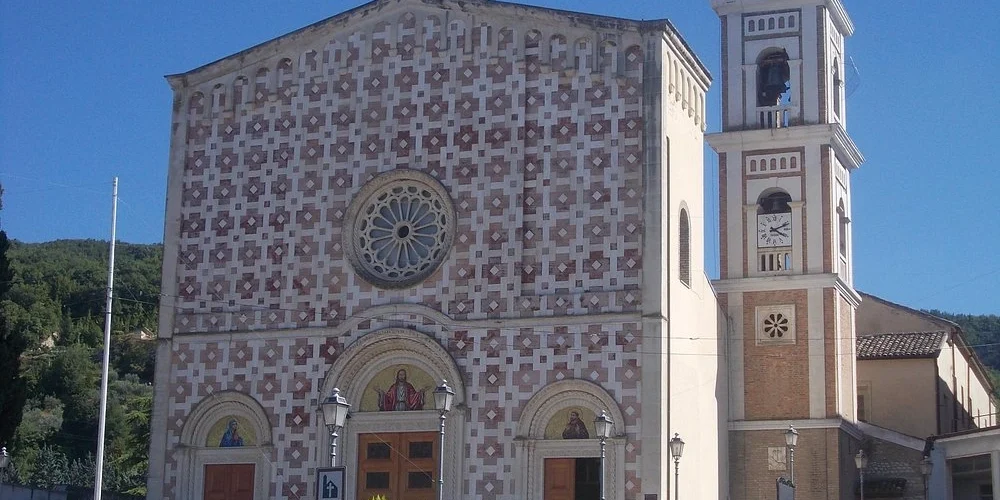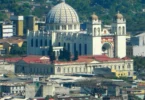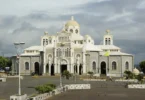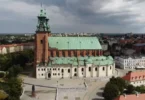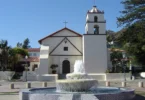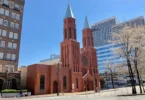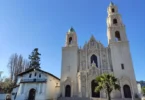Introduction
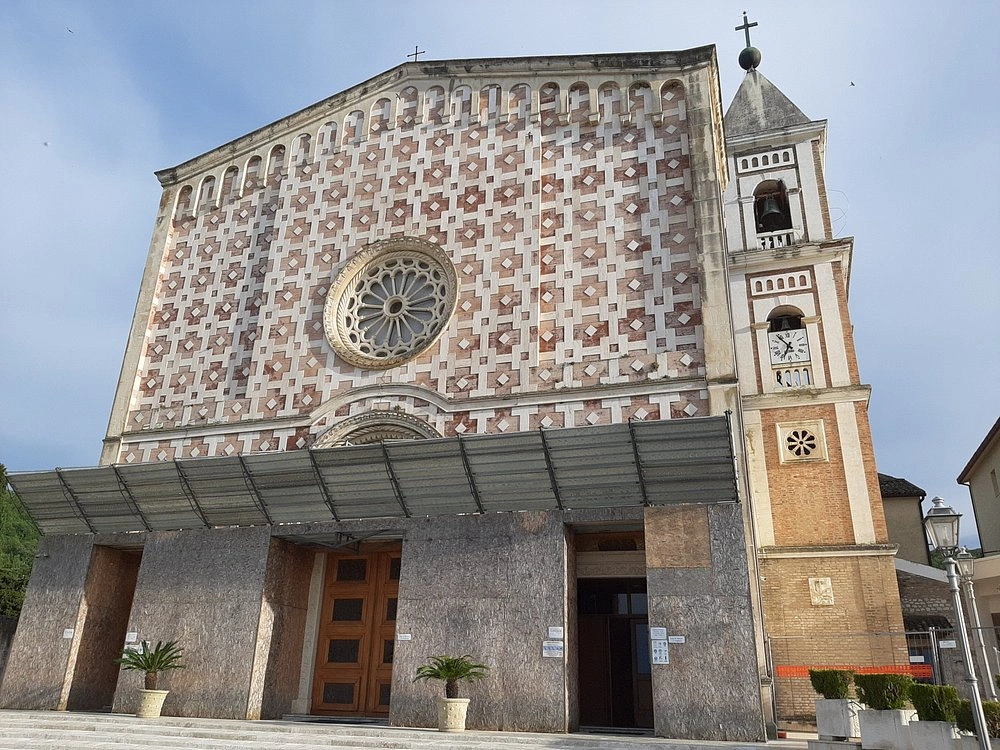
The Basilica of the Holy Face, also known as the Sanctuary of the Holy Face (Santuario del Volto Santo), is a revered Roman Catholic church located just outside the historic town of Manoppello, in the province of Pescara, within the Abruzzo region of Italy. Nestled in a peaceful setting at the site of a former Capuchin friary dedicated to Saint Michael the Archangel, the sanctuary is under the jurisdiction of the Archdiocese of Chieti-Vasto. The basilica holds immense spiritual and religious significance as the custodian of the Holy Face of Manoppello, a mysterious relic believed by many to be the Veil of Veronica—the cloth said to bear the miraculous image of the face of Jesus Christ. This sacred image, printed on an almost transparent fabric, is venerated by pilgrims from around the world, who come in devotion and wonder at what is regarded as a powerful testament to the Passion of Christ. Due to its growing importance as a pilgrimage site and the profound religious devotion it inspires, the church was visited by Pope Benedict XVI in September 2006, a historic moment that highlighted its universal value. That same year, the pope granted it the title of minor basilica, formally recognizing its significance in the Catholic Church.

Origins and Foundation
The history of the Sanctuary of the Holy Face in Manoppello dates back to the 16th century, when the convent was first documented. Situated on a hill just outside the town of Manoppello in the Abruzzo region of Italy, the convent gained significant religious importance in 1620 when it became the guardian of the revered Christian relic, the Holy Face of Christ. The relic’s transfer to the convent was facilitated by Donato Antonio de Fabritiis, a notary, who helped arrange the donation and the relocation of the sacred image to the Capuchin Fathers for safekeeping. Originally dedicated to Saint Michael and the Holy Name of God, the convent was soon renamed the Sanctuary of the Holy Face, and it rapidly grew to become one of the most important pilgrimage destinations in the region.
Suppression and Restoration
The sanctuary’s religious life was interrupted by the Napoleonic decrees of 1811, which led to the suppression of religious orders. The Capuchin friars were expelled, and the convent was briefly handed over to the Poor Clares. However, with the Bourbon restoration in 1816, the Capuchins were allowed to return and resume their custodianship of the sanctuary. The following decades saw restoration works in 1848, and in 1858, the convent expanded with the construction of a novitiate school, further emphasizing its growing role in religious education. After the unification of Italy and the introduction of Piedmontese laws in 1866, the convent was once again closed temporarily. Later, in 1876, the convent’s garden was seized and repurposed as a civil cemetery, a function it still serves today.
20th Century Developments
The 20th century marked a period of significant institutional and architectural developments at the sanctuary. In 1906, a periodical devoted to the Holy Face was launched, which helped solidify the sanctuary’s spiritual and cultural significance. By 1926, the convent became the site of the Seraphic Seminary of “San Michele,” an institution dedicated to religious education and training. The 1960s saw large-scale renovations and expansions to accommodate the increasing numbers of pilgrims visiting the sanctuary. While these modernizations were necessary, they also led to the destruction of much of the original Capuchin architectural style. The sanctuary’s original, simple façade and barrel-vaulted interior were replaced with more elaborate designs that could accommodate the growing religious community and visitors.
Architecture of Basilica of the Holy Face, Manoppello, Italy

Exterior Transformation
Pre-1960s Facade:
Before the 1960s reconstruction, the exterior of the Sanctuary of the Holy Face adhered to the traditional Capuchin architectural style common in Abruzzo. The façade was simple yet elegant, with a horizontal crown, a central window, and a small portico at the entrance. In the 1940s, plans were made to modify both the façade and the bell tower. The bell tower was constructed from exposed brick, while the façade was left unfinished and built from exposed bricks with salients (protruding elements). It also featured three entrances, with a central niche housing a statue of the Madonna.
Reconstruction in the 1960s:
In 1965, a major reconstruction project was undertaken, resulting in a complete transformation of the convent’s façade. The goal was to create a gabled façade inspired by ancient Romanesque churches. The new design utilized red and white stone blocks arranged in a geometric pattern with small crosses, echoing the design of the Basilica of Santa Maria di Collemaggio in L’Aquila. A large rose window, inspired by that of Collemaggio, was added at the center, and the three entrances were restructured with rounded arches. The central portal now features a decorated lunette mosaic depicting the Merciful Christ, enhancing the sanctuary’s grand and welcoming appearance.
The Bell Tower
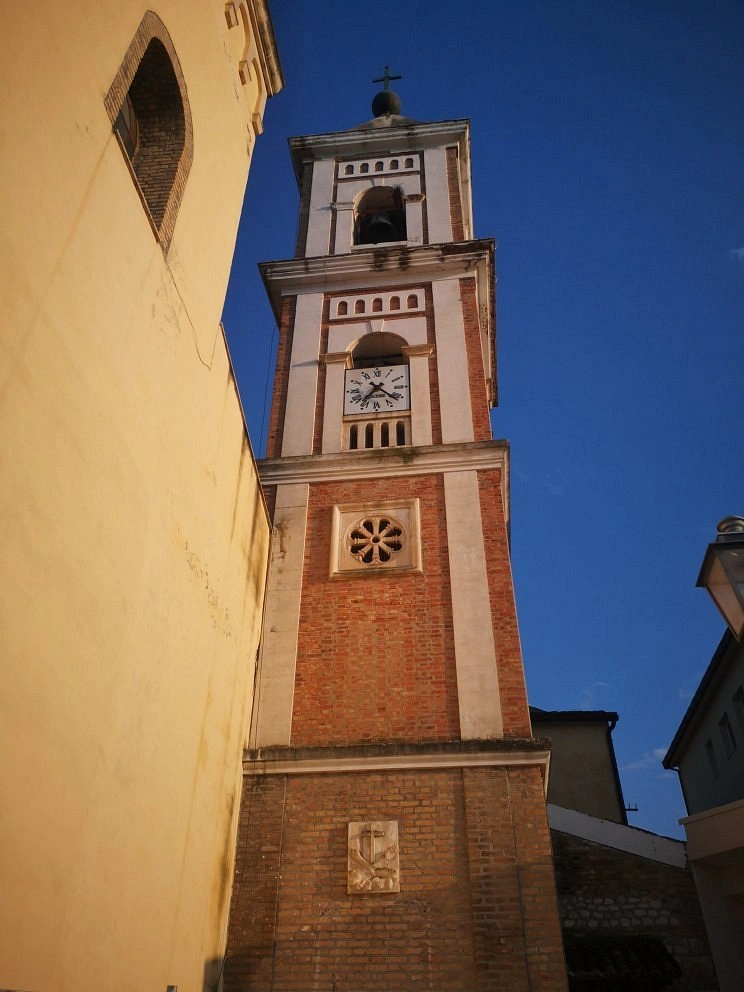
The original bell gable was demolished in the 1960s, and a new detached bell tower was constructed on the left side of the basilica. This tower, made from red bricks and adorned with white stone decorative elements, is divided into three levels separated by white stone cornices. It follows the Romanesque tradition, with rose windows in the lower section and arched openings for the bells in the upper sections. The bell tower adds a unique touch to the sanctuary’s architecture, marking a departure from its original, simpler design.
Interior Design and Religious Relics
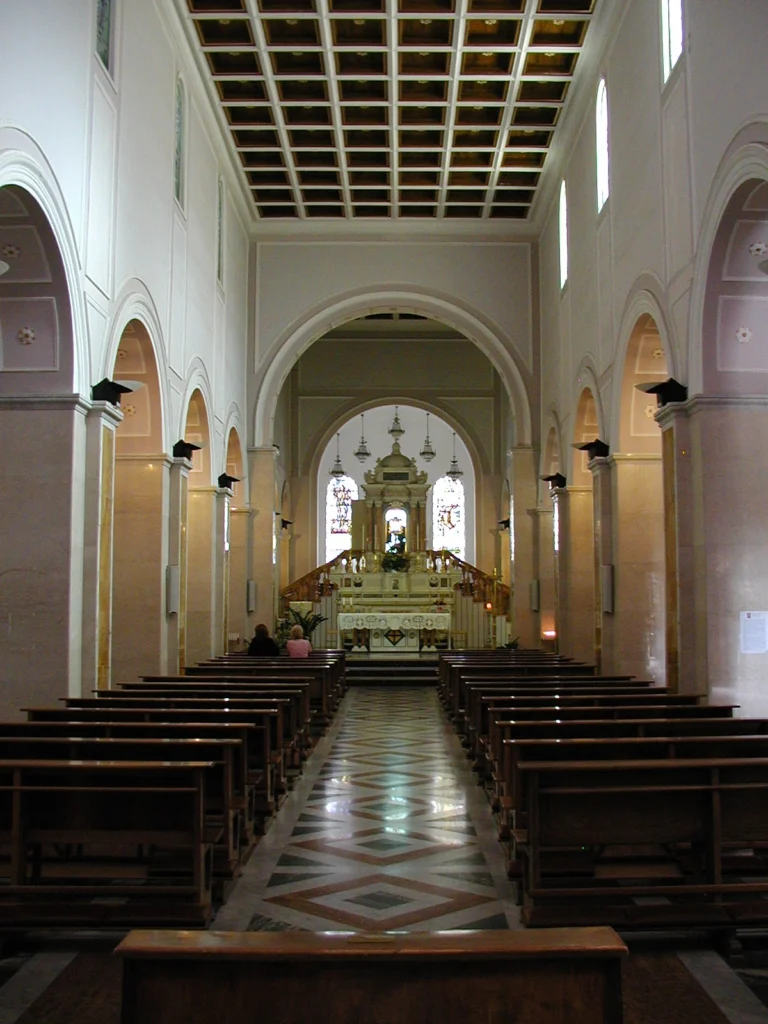
Nave and Chapels
Internally, the sanctuary underwent significant changes during the 1960s. The original single-nave layout was expanded to a three-nave configuration to better accommodate the growing number of pilgrims. The interior features an eclectic blend of neoclassical and late Art Nouveau elements. A row of columns divides the naves, and the sanctuary is further adorned with polychrome stained glass windows that illuminate the space and add vibrant color to the interior. At the heart of the sanctuary is the main altar, which houses a monumental tabernacle. The tabernacle displays the Holy Face relic, which is the focal point of the sanctuary’s spiritual life. Surrounding the altar are side chapels, each of which emphasizes the sacredness of the relic and its central role in the sanctuary’s devotion.
Chapel of the Madonna of Pompeii
One of the most significant features inside the sanctuary is the Chapel of the Madonna of Pompeii. This chapel is decorated in the late Baroque style, with intricate stucco work and elaborate details. It houses a sculptural group depicting the Madonna with Child, flanked by Saint Dominic and Saint Rose of Lima. The group is set within a stucco tabernacle supported by angels. The false stucco dome in the chapel features the Dove of the Holy Spirit at its center, surrounded by cherubs. Bas-reliefs on the sides of the chapel depict various Marian miracles. The Holy Face relic was originally housed in this chapel before being moved to its current place in the tabernacle behind the main altar. The altar table in the chapel is adorned with plant motifs, such as vine shoots, framing the image of the Mystic Lamb placed in the center. The chapel also contains a neoclassical tabernacle with the relics of Saint Stephen of the Wolf, who founded the monastery of San Pietro in Valle Bona in Manoppello. The tabernacle was crafted by Silvino Donatelli in 1914, with stucco decorations by Michele Patrignani in 1925.
Other Chapels and Artworks
To the left of the nave is a chapel containing the painting “Madonna Without Sin,” created by Renato Gattuso, which depicts the Immaculate Madonna surrounded by angels. On the right side of the nave is a painting of the Immaculate Madonna between Saint Francis and Saint Anthony, painted by Francesco M. De Benedictis from Guardiagrele in the 19th century. In addition to these works, the sanctuary houses several ancient paintings illustrating scenes from the lives of Saint Francis, Saint Rita, and The Lamentation of the Dead Christ. These paintings are part of the Museo del Volto Santo, offering visitors a glimpse into the sanctuary’s artistic and religious history.
Contemporary Artworks

Recent additions to the sanctuary include several contemporary sculptures, such as:
- St. Michael defeating the Devil
- St. Francis with the Cross
- A baptismal font, commissioned by Monsignor Bruno Forte, Archbishop of Chieti-Vasto
In 2017, a new pulpit with a seat and Easter chalice was created by the artist Alberto Cicerone, marking another modern addition to the sanctuary.
Wooden Choir and Stained Glass
The wooden choir behind the reliquary tabernacle contains 18th-century paintings of Capuchin saints such as Dan Fedele and San Giuseppe da Leonessa. The stained-glass windows, created by the D’Aurelio Company of Atri in 1948, depict scenes from the life of Christ and various saints, adding to the spiritual atmosphere of the sanctuary.
The Holy Face Relic
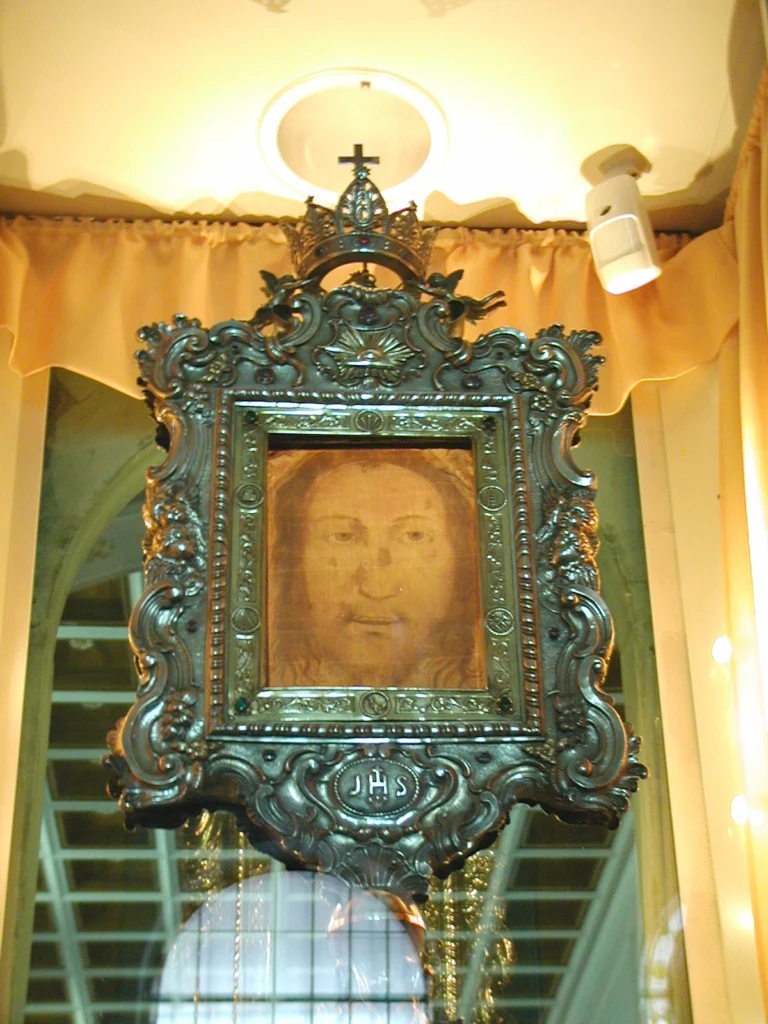
The Holy Face relic is the central element of the sanctuary and is displayed in a raised tabernacle behind the altar. Protected by a glass case, the relic is housed in a 19th-century neoclassical tabernacle, supported by cherubs and featuring Ionic volutes. A double staircase allows pilgrims to approach the relic directly, creating a solemn and reverent space for reflection.
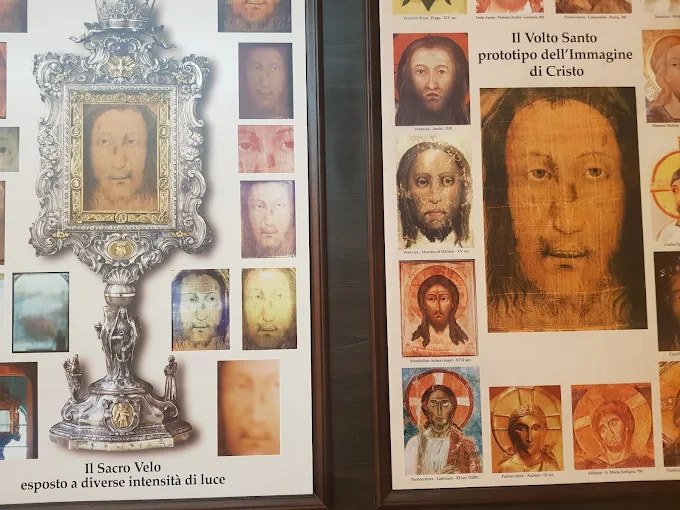
Museum of the Holy Face
The convent houses a small museum dedicated to ex votos, which are religious offerings made by pilgrims in gratitude for favors received. These offerings, which feature popular craftsmanship, are of great ethnoanthropological interest. The museum also displays objects that once belonged to the Capuchin friars, including a collection from Father Domenico da Cese of Avezzano. The ex votos and other religious artifacts offer visitors a deeper understanding of the cultural practices and spirituality of the pilgrims who have visited the sanctuary over the centuries.
Feast Day
Feast Day : 06 August
The Basilica of the Holy Face in Manoppello, Italy, celebrates the Feast of the Holy Face on the third Sunday in May, the Feast of the Transfiguration on August 6, and the Feast of Omnis Terra in January. These feasts honor the sacred image of the Holy Face, drawing pilgrims for liturgical services and processions.
Church Mass Timing
Monday to Friday : 7:30 AM
Saturday : 5:30 PM
Sunday : 8:00 AM , 9:30 AM , 11:00 AM , 5:00 PM
Church Opening Time:
Monday to Sunday : 6:00 am – 12:30 pm., 3:00 pm – 7:30 pm
Contact Info
Address : Basilica of the Holy Face
Via Cappuccini, 26, 65024 Manoppello PE, Italy
Phone : +39 085 859118
Accommodations
Connectivities
Airway
Basilica of the Holy Face, Manoppello, Italy, to Abruzzo Airport, distance between 33 min (28.4 km) via E80.
Railway
Basilica of the Holy Face, Manoppello, Italy, to Manoppello Railway Station, distance 3 min (1.8 km) via Via Cappuccini and SS539dir.

